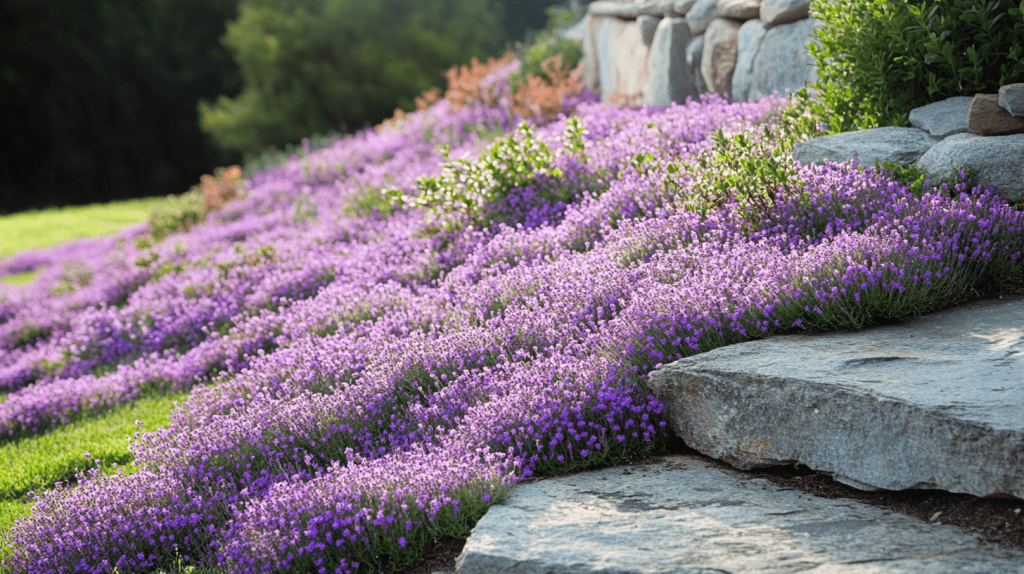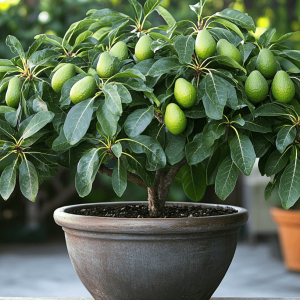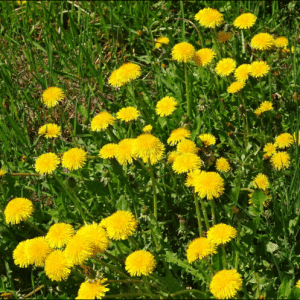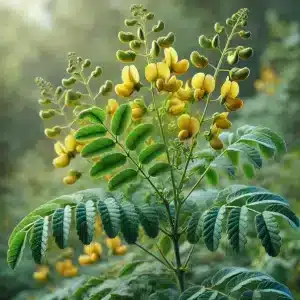
If your lawn tends to wither and lose its charm every summer, consider making a switch to a creeping thyme lawn. Not only is creeping thyme an aesthetically pleasing alternative to traditional grass, but it also offers a plethora of practical benefits.

Benefits of a Creeping Thyme Lawn
Drought Tolerance
Creeping thyme is highly drought-tolerant, making it an excellent choice for areas prone to dry spells. Unlike traditional grass that can turn brown and brittle, creeping thyme remains lush and green, requiring far less water.
Weed Suppression
One of the standout features of creeping thyme is its ability to choke out competing plants. Its dense growth pattern leaves little room for weeds, ensuring a clean and uniform appearance without the constant need for weeding.
Low Maintenance
Most varieties of creeping thyme stay under 4 inches in height, which means you can say goodbye to weekly mowing sessions. This low-growing nature not only reduces maintenance but also creates a neat and manicured look year-round.
Foot Traffic Friendly
Creeping thyme can handle a fair amount of foot traffic, making it suitable for pathways and areas where people frequently walk. Its resilient nature ensures it remains intact and beautiful despite regular use.
Pollinator Friendly
When in bloom, creeping thyme produces a profusion of tiny flowers that are a boon for bees and other pollinators. By choosing creeping thyme, you’re not just beautifying your lawn but also supporting local biodiversity.
Aromatic Delight
While many people love the smell of freshly cut grass, the fragrance of a sunbaked lawn of creeping thyme is an experience unto itself. The aromatic oils released by the thyme add a pleasant scent to your outdoor space.
How to Replace Your Grass Lawn with Creeping Thyme
Step 1: Preparing the Soil
- Clear the Area: Remove any existing grass, weeds, and debris from the area where you want to plant creeping thyme.
- Till the Soil: Loosen the top 6-8 inches of soil using a tiller or a garden fork. This will help the thyme establish strong roots.
- Amend the Soil: Mix in compost or well-rotted manure to enrich the soil. Creeping thyme prefers well-drained soil, so if your soil is heavy clay, consider adding sand to improve drainage.

Step 2: Planting Creeping Thyme
- Choose the Right Variety: There are several varieties of creeping thyme to choose from. Consider options like ‘Elfin’ thyme for a very low-growing plant, ‘Mother of Thyme’ for larger areas, or ‘Doone Valley’ thyme for a mix of green and golden foliage.
- Planting: Space the plants about 6-12 inches apart. If planting from seeds, scatter them over the prepared soil and lightly press them in.
- Watering: Water the newly planted thyme thoroughly and keep the soil moist until the plants are established. Once established, thyme requires minimal watering.
Step 3: Ongoing Care
- Watering: After the initial establishment period, creeping thyme only needs to be watered during prolonged dry spells.
- Pruning: Trim back the plants lightly after flowering to maintain a tidy appearance and encourage new growth.
- Fertilizing: Creeping thyme doesn’t need much fertilization. An annual application of compost should suffice.
Alternatives to Grass Lawns: Three Hardy Options
If creeping thyme isn’t quite what you’re looking for, here are three other ground covers that can replace traditional grass lawns and offer greater resilience:
1. Clover (Trifolium repens)
Clover is a nitrogen-fixing plant that enriches the soil and requires minimal maintenance. It stays green during dry periods, needs little mowing, and attracts pollinators with its small white flowers.
2. Sedum (Sedum spp.)
Sedum, or stonecrop, is a succulent that thrives in poor, dry soil. It forms a dense mat of foliage and produces star-shaped flowers in various colors. Sedum is excellent for hot, sunny areas and requires little water.
3. Chamomile (Chamaemelum nobile)
Chamomile creates a fragrant and visually appealing lawn alternative. It’s drought-tolerant, low-growing, and produces small, daisy-like flowers. Chamomile lawns are soft underfoot and release a pleasant scent when walked on.

Conclusion
Switching to a creeping thyme lawn, or one of the other hardy alternatives, can transform your outdoor space into a beautiful, low-maintenance haven. Whether you opt for the aromatic allure of thyme, the resilience of clover, the succulence of sedum, or the charm of chamomile, you’ll enjoy a lush, green lawn that stands up to the challenges of summer and beyond. Embrace the change and enjoy a stunning, sustainable landscape all year round.






